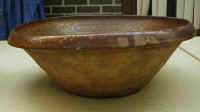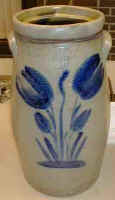©1999-2015
Wisconsin Pottery Association
P.O. Box 705
Madison WI 53701-0705
The following article appeared in WPA Press, Vol. 4, April 2000
Early Wisconsin Pottery
 March 14 Mark Knipping of the State Historical Society of Wisconsin brought some
of his stoneware collection to the WPA meeting, and demonstrated, per-haps
inadvertently, that stoneware collectors don’t mess around. In case you think
you like stoneware and might try to pick up a piece at a sale here or there, you
might reconsider after hearing Mark’s talk. It seems that the stoneware
collectors are an extremely dedicated group, driving miles to sales, at all
hours of the day or night, for a chance to add to their collections. What makes
them do it?
March 14 Mark Knipping of the State Historical Society of Wisconsin brought some
of his stoneware collection to the WPA meeting, and demonstrated, per-haps
inadvertently, that stoneware collectors don’t mess around. In case you think
you like stoneware and might try to pick up a piece at a sale here or there, you
might reconsider after hearing Mark’s talk. It seems that the stoneware
collectors are an extremely dedicated group, driving miles to sales, at all
hours of the day or night, for a chance to add to their collections. What makes
them do it?
Mark began his talk by explaining that potters learned early on that Wisconsin’s soil was not really suitable for stoneware or earthen-ware. And that it was easier during the mid-19th century, to take the potter to the clay than the clay to the potter. Due to limited means of transportation back then, moving materials such as clay around was simply not practical.
But there was stoneware and earthenware produced in Wisconsin, and Mark explained the distinctions between the two potteries and production times. The earliest pieces produced in Wisconsin, were earthenware pots. Made of red clay, this product is also known as “red-ware”. It is traditionally glazed on the inside only, as the Wisconsin clay resulted in a porous pot that would not hold liquid without the glaze, which served as a sort of lining. From the information Mark has gathered we know that one earthen-ware producer was still advertising his pieces in 1893, and that he died in 1899. (Sorry that poor note-taking prohibits me from providing further information, but other club members probably can fill in the gaps here.)
Along the shore of Lake Michigan clay could more easily be transported, which meant that potters didn’t have to rely so much on the local supply and soil type. Thus Wisconsin stoneware was born. Pieces from as early as 1840s have been found.
Mark pointed out that they differed from earthenware in that they tended to be made by factory, versus smaller home-based businesses for earthenwares. Mark pointed out that the shape of some pieces helps tell their production dates. The earlier, 1840s jugs had sloping, less defined shoulders, while the turn of the century brought the “beehive” shape, with sharply defined shoulders.
 There are serious quality differences
between stoneware and red-ware. Redware was fired at about 1700°F, while
stoneware was fired much higher, perhaps 2700°F. The higher firing temperatures
vitrified the silica in the clay, literally turning it into glass. Thus
stoneware is nonporous and holds liquid.
There are serious quality differences
between stoneware and red-ware. Redware was fired at about 1700°F, while
stoneware was fired much higher, perhaps 2700°F. The higher firing temperatures
vitrified the silica in the clay, literally turning it into glass. Thus
stoneware is nonporous and holds liquid.
The early stoneware producers were commonly German immigrant as tells a common motif on stoneware, the tulip, popular in Germany as a design element. If you see a stoneware piece with a tulip flower (and this design appears to have been rather liberally interpreted in some cases, with flowers hardly recognizable as tulips in many cases) you can be fairly certain that it is a German potter’s handiwork.
The heyday for stoneware manufactured in Wisconsin was 1848-1875, with the Redwing company firing up their stoneware kilns and production about 1862. It was interesting to learn that Redwing shipped it’s stoneware all over the country, so Redwing Stoneware has a very large US-wide collecting market. It is very possible, and even believed by some, that Redwing drove a number of other stoneware producers out of business. Thanks to Mark for his fascinating presentation on very old Wisconsin pottery! - Kari Kenefick
Related Pages:
Related Sites: (The sites will open up in a new window)
Mr Bottles - Has an extensive listing of over 100 clay beer bottles made in Wisconsin from 1850 until the turn of the century. The listings include name, location and pictures of many. Be sure to read the introduction to clay bottles because it contains information about how they were made, of what materials, the markings and much more. Recently added were pictures of Wisconsin Antique Stoneware.








